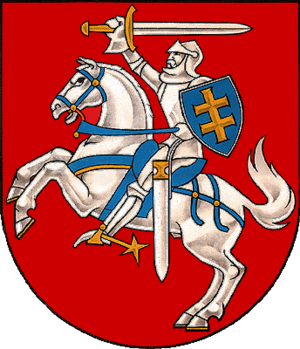Coat of Arms of Lithuania
|
|
The Coat of arms of the Republic of Lithuania is the Vytis (the Chase).
Structure
The heraldic shield features a red field with an armored knight on a white (silver) horse holding a silver sword in his right hand above his head. A blue shield hangs on the left shoulder of the charging knight with a double gold (yellow) cross on it. The horse saddle, straps, and belts are blue. The hilt of the sword and the fastening of the sheath, the charging knight's spurs, the curb bits of the bridle, the horseshoes, as well as the decoration of the harness, are gold.
History
The charging knight is known to have been first used as the state emblem in 1366. It is featured on the seal of the Grand Duke of Lithuania, Algirdas, which marks a document belonging to that year. The old prototype of the present Vytis depicts a knight on horseback holding a sword in his raised hand. The symbol of the charging knight on horseback was handed down through the generations: from Algirdas to his son, Grand Duke Jogaila, then to Grand Duke Vytautas and others. By the 14th century, the charging knight on horseback with a sword had begun to be featured in a heraldic shield, first in Jogaila's seal in 1386 or 1387, and also in the seal of Vytautas in 1401. As early as the 15th century, the heraldic charging knight on horseback became the coat of arms of the Grand Duchy of Lithuania and of its central part - the Duchy of Vilnius. 16th century documents refer to it as Vytis (it is believed that the word Vytis was used in the 15th century). At first, the charging knight was depicted riding in one or the other direction and sometime held a lance. But as of the first half of the 15th century, he is always shown riding to the left (as see by the viewer) with a sword in his raised hand and a shield in the left hand.
In the 15th century, the colors of the seal became uniform. The livery colors became fixed: a white (silver) charging knight on a red field of the heraldic shield. The shield of the charging knight was blue then and set against the blue field was a double (gold) cross. The coat of arms featured the grand duke's headgear on the crest.
At first, the charging knight showed the figure of the ruler of the country, but with time it came to be understood and interpreted as that of a riding knight who was chasing an intruder out of his native country. Such an understanding was especially popular in the 19th century and the first half of 20th century. The explanation has a sound historical foundation. It is known that at the Zalgiris (Grunwald) battle, where the united Polish-Lithuanian army crushed the army of the Teutonic Knights, thus putting an end to its expansion to the east, thirty Lithuanian regiments out of the total forty were flying with the sign of the Vytis.
With minor stylistic changes, the Vytis coat of arms remained the state symbol of the Grand Duchy of Lithuania until 1795, when Lithuania was annexed by Russian Empire. The Vytis was then incorporated into the imperial state emblem.
While restoring the independent Lithuanian state in 1918-1919, due care was taken to restore the state emblem too. A special commission was set up to analyse the best 16th century specimens of Vytis to design a state emblem. Only the crest with the grand duke's headgear was rejected. The Vytis was the state emblem of the Republic of Lithuania until 1940, when the Republic was annexed by the Soviet Union.
Pogon.png
At collapse of the Soviet Union, Vytis, together with Gedimino Stulpai and other historical emblems became symbols of a revival movement in Lithuania, outlawed by the Soviet government but present at rallies of Sajudis. It was only in 1988 that the Vytis was again legalized as a national symbol. As of March 11, 1990 the Vytis is once again the official state emblem and symbol of the Republic of Lithuania. On April 10, 1990 the Supreme Council of Republic of Lithuania approved the description of the state emblem and determined the principal regulations for its use. On September 4, 1991, the old colors of the Vytis seal were re-established.


